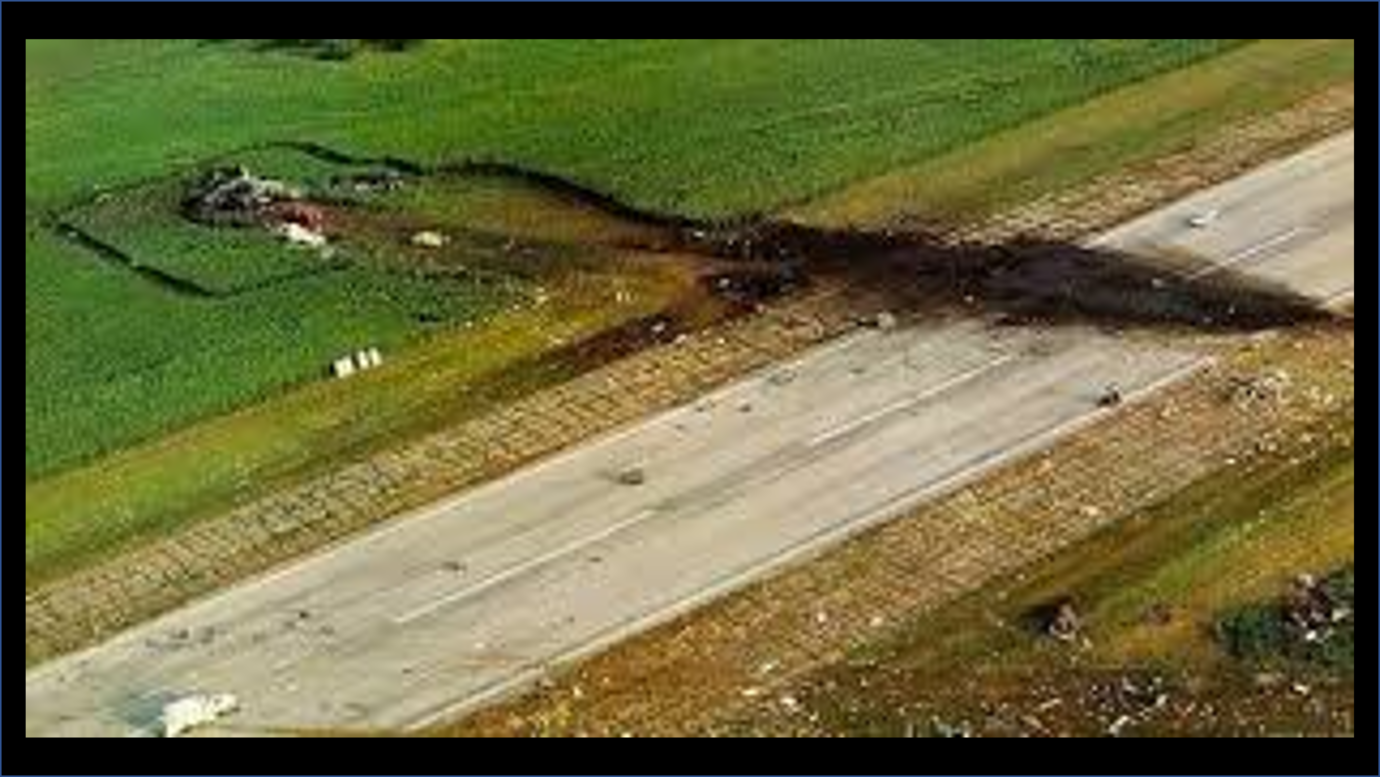Time and again in history, we find events that usher in a new era and serve as landmarks for meaningful developments. The tragic crash landing of a United DC-10 in Sioux City in 1989 is one such event. This incident marked the transformation of an outdated understanding of leadership in aviation into a contemporary form of leadership.
United Flight 232
What happened? The aircraft was cruising between Denver and Philadelphia at an altitude of 30,000 feet when the middle of the three engines explosively disintegrated and flying debris damaged all three hydraulic systems. The aircraft was virtually uncontrollable from that point on. In the cockpit were Cptn Haynes, the first officer, and the flight engineer. The two pilots managed to keep the aircraft in a descending turn by pulling the control column back with maximum body power and bracing against the turn with full aileron deflection. That was all they could do. The crash was only a matter of time before the aircraft would hit the ground curving like this. In distress, Captn Haynes remembered the DC-10 flight instructor aboard as a passenger and offered him to help. He managed to steer the aircraft from the middle seat in the cockpit, using the two thrust controls of the still-functioning wing engines. He was able to steer the aircraft with the two thrust controls of the still functioning wing engines, although this was more a case of rough directional and very imprecise descent rate control.
In a feat that could not be reproduced later, the four cockpit members managed to bring the DC-10 to the ground at Sioux Gateway Airport in Iowa. However, there could be no talk of a landing. On impact, the plane flipped onto its back, caught fire and broke into four pieces. Of the 296 people on board the plane, 111 died. On the other hand, 185 people survived the accident. There were a few favorable circumstances that minimized the death toll. The most significant aspect was explained by Cptn Haynes after the incident as follows: "Until the 1980s, the captain was the authority on board. What he said was valid. That's how we lost some aircraft. Sometimes the captain wasn't as good as we all thought he was. In Sioux City, none of us knew what to do. Why should I, of all crew members, have known how to proceed? But the four of us had 103 years of combined pilot experience. By each of us contributing fully, we managed to get the DC-10 on the ground in Sioux City."
A new understanding of leadership
This is a leader who does not pretend to himself and all his employees that he is the master of all situations. With this statement, Cptn Hayens has openly broken with the hero myth of the "Gods in Blue. He not only refuses to highlight his personal achievements in retrospect. Rather, he meets his challenge from a humble inner attitude. It is this attitude that made the necessary and successful teamwork possible in the first place. An attitude that does not allow him, just because he is the boss, to do anything that would not be a viable response to the problem. He uses the resources at his disposal in the best possible way and does not allow his ego to prefer to see him in a particularly prestigious role. His uniform jacket with the four stripes and his captain's hat are in good hands in the back of the wardrobe. They can' t cause any collateral damage there.
Why we no longer need heroes
What is presented here in an extreme way in the emergency and comes to the fore in an edgy way plays itself out thousands of times in highly complex work and leadership environments in normal operations. In Sioux City, the emergency confronts a leader and demands that he solve a problem he does not know. Elsewhere, relentless competition demands a ability of adaptation and innovation from the company and its executives, calling for solutions they don't yet know. Ultimately, this is the same context in which 'leadership' is called for in a special way. Not only demanded by the crisis, but also by the pressure to adapt and innovate, diversity, inclusion, collaborative understanding of leadership, agile management and the associated social competencies of the leader are pushing themselves so prominently to the fore. They are all important elements of resource-based leadership. As a boss or expert, if I don't know what the answer to the problem is, the hero pedestal I stand on is of precious little help. If I don't manage to climb down in such situations or environments, it becomes dangerous. Then the cumulative power of the heroes becomes a risk for the company. For there is a danger that things will be done that are not meant for problem solving, but for maintaining power or face-keeping. In my various engagements as a coach and trainer of crisis teams, I have witnessed and continue to witness such misguided actions by people in positions of responsibility. Since the ongoings are always visible to all involved, they are also the triggers of meticulous embarrassment or even frustration in the team.
Humility as a basis
Humility protects managers and specialists from such dangerous escapades. It helps them see their performance expectations free of formal or organizational demands and opens their eyes to what needs to be done. No politics and no cover-your-ass strategies. Humility frees leaders from such corrosive self-protection mechanisms and allows them to make an authentic appearance that makes them approachable and vulnerable. Yes, it is like that: Those who are approachable and vulnerable are trusted. Humility turns heroes into team players.
What is still interpreted by many managers and experts today as 'not being up to the job' or even as a sign of failure, proved to be a success in Sioux City. The incident teaches all those who like to bathe in their expertise and use it to legitimize their power something different.
Humility lays the groundwork for an attitude that does not presume to have a solution to every problem or to always be able to maintain control over everything. It is based on the honest admission of one's own imperfection and personal overstrain as an individual in complex systems or challenging situations, in environments with threatening pressure to innovate or in states of crisis.
A humble attitude also helps those leaders who are in charge in high-risk organizations. Here, a humble and reverent view of a complex system, which is usually highly regulated but can no longer be understood holistically in all its facets and overlapping, mutually influencing functions, helps. This inner attitude allows leaders to create a fear-free atmosphere, a culture of trust. By establishing an environment of psychological safety, they ensure that information flows smoothly throughout the organization. Horizontally as well as vertically. In highly complex environments, this leads to reporting the weak points of the system. This is an indispensable prerequisite for the continuous learning process and thus for the safety and reliability of the organization.
What should be done when managers are overwhelmed?
Well, they are only overwhelmed if they uphold an understanding of leadership that makes them exclusively responsible for the result. Such an output-oriented understanding can make sense in simple and linear environments and systems. But in complex and networked situations, which are characterized by a high degree of interdependence, it becomes a complete overload. Where we can steer and control in simple systems, we are limited to influence in complex systems and in crises. The diversity and interconnectedness of influences take away the power of steering and control. A humble attitude can help the leader move away from a historically entrenched focus on results. The role he or she has to play in complex, networked environments characterized by pressure to adapt is dedicated to achieving results. Leaders are responsible for all the processes, structures and cultural frameworks that optimize the facilitation of good solutions. In fact, they are there to organize collaboration. In such a way that all the resources of the company are brought to bear in the best possible way. We are therefore well advised when assessing the performance of managers not to focus solely on the result, but rather to evaluate their abilities, which were decisive in achieving the result.
They can' t do this without trust. Nor can they do so without a sense of purpose. And without humility, it will be difficult.
Christmas at last!
Fortunately, the holidays are just around the corner. They offer us the opportunity to reflect on things that are understandably neglected in everyday life. Christmas, however, as the feast of love, provides an ideal setting to let our thoughts revolve around the virtue of humility. In the German language, the word humility comes from the old High German word 'diomuoti'. This stood for 'attitude of a servant'. This meaning has a lot in it when it comes to clarifying your own understanding of leadership. I wish all readers of this blog a Merry Christmas and a successful, because relaxed, start into the New Year.



